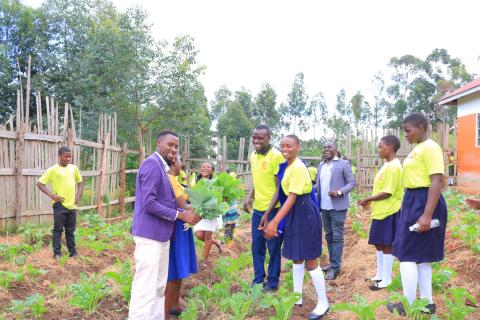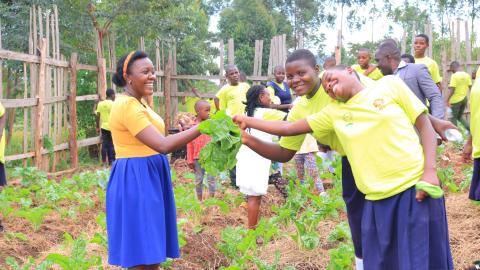Fighting Malnutrition in Kyenjojo: A Community Struggle with Hope on the Horizon
In the lush green hills of Western Uganda, Kyenjojo District is battling a silent but devastating crisis—malnutrition. While the district is blessed with fertile soils and a hard-working agricultural population, many families still struggle to provide their children with the nutritious meals needed for healthy growth and development.
According to recent health data, 41% of children under five in Kyenjojo are stunted, a condition caused by chronic undernutrition. Additionally, underweight births remain high, with about 50% of infants born weighing below the healthy threshold, putting them at risk of early mortality and long-term developmental delays.
Malnutrition in Kyenjojo is not always a result of food scarcity. In many cases, it's about limited dietary diversity and low awareness of proper nutrition practices. Families mainly rely on staple crops like cassava, matooke, beans, and maize, which fill stomachs but lack essential nutrients such as proteins, iron, and vitamins.
"This is not just about lack of food—it is about the right kind of food," said Mr. Raymond Nyabongo, the District Nutritionist. "We have children eating enough in quantity but not in quality."

RAYMOND NYABONGO District Nutritionist on a tour of school demo gardens at Katooke SS
In response to these challenges, a number of government and NGO-led interventions are taking root in Kyenjojo, and impressively making a difference.
The Ministry of Health recently commissioned and deployed over 330 Community Health Extension Workers (CHEWs) in Kyenjojo to deliver health and nutrition services at the grassroots level. These CHEWs conduct regular household visits, provide nutrition counseling to mothers, and refer malnourished children to health facilities for treatment.
CHEWS after being commissioned by PS Ministry of Health, Dr. Diana Atwiine.
"Our goal is to catch malnutrition early," explained Mr. Peter Katusabe, a CHEW in Nyantungo Sub-county. "We check for signs of wasting, educate mothers on breastfeeding, and promote proper complementary feeding practices."
Several schools in the district have introduced school feeding, nutrition and demonstration gardens, where children and teachers grow vegetables like carrots, sukuma wiki, and beans. These gardens serve as both a learning tool and a source of school meals, increasing attendance and improving dietary intake.
The gardens are supported by Kyenjojo Association of Women Development Actors (KAWODA),awomen-led, locally registered NGO based in Kyenjojo, focused on promoting economic empowerment of smallholder farmers through agriculture diversification, value addition, and sustainable marketing.
KAWODA also employs a graduation model, working household by household—especially chronically food-insecure households living on under $1.90 a day; to build capacity, improve food security and nutrition outcomes which encourages home and school gardening, dietary diversification, and improved sanitation.
The District also has an active District Nutrition Coordination Committee, a multi-sectoral coordination body established at the district level to oversee, coordinate, and guide nutrition programming and policy implementation. It is part of Uganda’s decentralized response under the Uganda Nutrition Action Plan (UNAP) and subsequent UNAP II (2020–2025). This is charged with ensuring nutrition is mainstreamed in the District Development Plan, sectoral work plans, and annual budgets, and Serve as the central platform for aligning all nutrition-related activities within the district.
Members of the DNCC at the Quarterly coordination meeting

Immaculate Atuhurra, the District Planner, and member DNCC at Katooke SS DEMO garden
DNCC members in a group photo with the school nutrition debate champions at Katooke SS
DNCC visit to Bufunjo subcounty on a good feeding and nutrition sensitization campaign
Despite these efforts, malnutrition continues to pose a significant threat. Access to clean water, poor sanitation, and recurring illnesses such as malaria and diarrhea further reduce children's ability to absorb nutrients from food.
Moreover, poverty remains a key underlying factor. Many families cannot afford protein-rich foods like meat, fish, or milk regularly.
"There are days when we eat only cassava and beans," said Jane, a mother of four from Kyarusozi. "Vegetables are sometimes seen as a luxury."
Health officials in Kyenjojo are calling for increased funding for nutrition programs and stronger community involvement. The district plans to expand its CHEW program, strengthen data collection, and collaborate with local leaders to promote nutrition at household and community levels.
"If we are to defeat malnutrition, it has to start in the homes, in the gardens, and in our schools," said Mrs. Anita Babukiika, the Assistant District Health Officer, Kyenjojo. "We must make nutrition a daily priority."
While the battle against malnutrition in Kyenjojo is far from over, the district is making strides through grassroots interventions and renewed government commitment. With continued support, education, and awareness, there is hope that no child in Kyenjojo will be left behind due to poor nutrition.